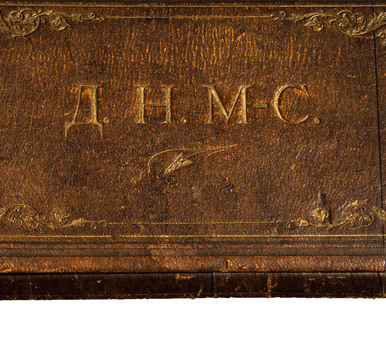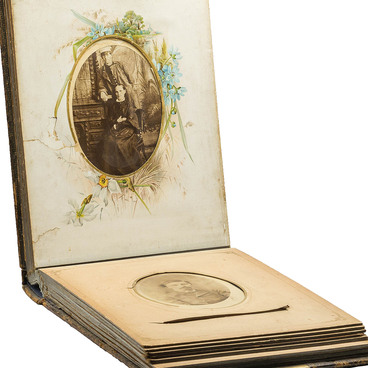The painting “Bark on the Kama River near Perm” was created by the Ural artist and writer Alexey Pogorelov (Sigov). The canvas was given to the museum by the painter’s son Mikhail Sigov. In the museum, it is displayed in a room of brothers Nikolay and Vladimir Mamins.
In the foreground, Pogorelov depicted the wooden stern of a bark that sails along the river. The banks of the Kama River seem to be opposed to each other. On the right side there is a gentle sandy slope; several fishing boats are moored near it. In the distance, one can see small wooden houses. To the left, beyond the steep ravine, there are mountains and the city painted on the horizon. The water reflects the bright sky and cumulus clouds.
Alexey Pogorelov was born in Perm on February 10, 1860. His father was a serf at the estate of the Vsevolozhsky industrialists. At first, he served there as an office clerk, and later, as an estate manager.
When Pogorelov was 10 years old, he moved to Krasnoufimsk to enter a non-classical school, a secondary school with a mathematical and natural science profile. After that, the future writer and artist enrolled at the Institute of Civil Engineers in St. Petersburg in 1881.
In the capital, Alexey Pogorelov became a member of the revolutionary movement. He was arrested, imprisoned, and then exiled to his homeland, the Perm Zemstvo. There, he began to write a lot and publish his works. In 1895, his story was printed in the magazine “Russian Thought” [“Russkaya Mysl”], and in 1899 — in “Russian “Russian Wealth” [“Russkoe Bogatstvo”].
In early 1905, Pogorelov returned to St. Petersburg, where he took part in the first Russian revolution: he worked for the Socialist-Revolutionary Party, published his works in newspapers and magazines, and himself published the people’s magazine “News” [“Vesti”] or “National News” [“People’s Vesti”] — the name changed. Alexey Pogorelov painted when he had free time.
After the 1905 Russian Revolution, the writer’s works began to be printed less and he earned money by non-literary work. Pogorelov got a job at the Bureau of Insurance Societies. At first, he was a representative of the company: he inspected the cities and developed insurance rates for them. Three years later, Pogorelov was appointed responsible secretary of the bureau, and in 1914, he was appointed manager.
During the events of 1917, Alexey Pogorelov returned to journalism: he became one of the editors of the newspaper “People’s Will” [“Volya Naroda”]. At the end of the 1910s, the writer fell seriously ill. In January 1920, he was gone.
In the foreground, Pogorelov depicted the wooden stern of a bark that sails along the river. The banks of the Kama River seem to be opposed to each other. On the right side there is a gentle sandy slope; several fishing boats are moored near it. In the distance, one can see small wooden houses. To the left, beyond the steep ravine, there are mountains and the city painted on the horizon. The water reflects the bright sky and cumulus clouds.
Alexey Pogorelov was born in Perm on February 10, 1860. His father was a serf at the estate of the Vsevolozhsky industrialists. At first, he served there as an office clerk, and later, as an estate manager.
When Pogorelov was 10 years old, he moved to Krasnoufimsk to enter a non-classical school, a secondary school with a mathematical and natural science profile. After that, the future writer and artist enrolled at the Institute of Civil Engineers in St. Petersburg in 1881.
In the capital, Alexey Pogorelov became a member of the revolutionary movement. He was arrested, imprisoned, and then exiled to his homeland, the Perm Zemstvo. There, he began to write a lot and publish his works. In 1895, his story was printed in the magazine “Russian Thought” [“Russkaya Mysl”], and in 1899 — in “Russian “Russian Wealth” [“Russkoe Bogatstvo”].
In early 1905, Pogorelov returned to St. Petersburg, where he took part in the first Russian revolution: he worked for the Socialist-Revolutionary Party, published his works in newspapers and magazines, and himself published the people’s magazine “News” [“Vesti”] or “National News” [“People’s Vesti”] — the name changed. Alexey Pogorelov painted when he had free time.
After the 1905 Russian Revolution, the writer’s works began to be printed less and he earned money by non-literary work. Pogorelov got a job at the Bureau of Insurance Societies. At first, he was a representative of the company: he inspected the cities and developed insurance rates for them. Three years later, Pogorelov was appointed responsible secretary of the bureau, and in 1914, he was appointed manager.
During the events of 1917, Alexey Pogorelov returned to journalism: he became one of the editors of the newspaper “People’s Will” [“Volya Naroda”]. At the end of the 1910s, the writer fell seriously ill. In January 1920, he was gone.



